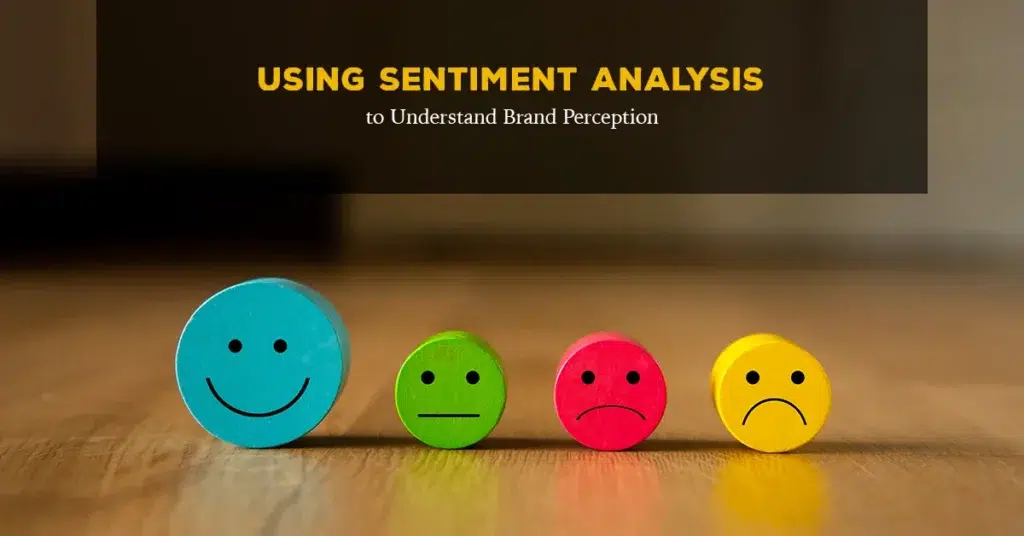
Sentiment analysis is a highly effective method for gaining a deeper understanding of brand perception. By leveraging analytics, businesses can assess customer emotions and opinions in real time, allowing for a more nuanced understanding of their brand’s image. Automatic sentiment analysis utilizes machine learning algorithms to classify sentiments in text data as positive, negative, or neutral, offering advantages in scalability and speed over manual methods.
The continuous flow of content from social media platforms offers a rich source of data, enabling brands to extract meaningful insights through advanced, sentiment classification and analysis techniques.
The wealth of data uncovered reveals clear patterns in consumer behaviour, providing actionable insights. When integrated into a comprehensive branding strategy, sentiment analysis enables businesses to fine-tune their approach and craft more relevant, consumer-focused strategies.
In addition, sentiment analysis plays a crucial role in optimising content management, ensuring that brand messaging resonates more deeply with target audiences. Recent innovations in analytics have further enhanced the accuracy and impact of these insights, ultimately improving how a brand is perceived. By utilising sentiment analysis, brands are empowered to forge stronger, more authentic connections with their consumers, shaping future strategies with greater precision.
Understanding Sentiment Analysis

Definition and Purpose
What is Sentiment Analysis?
Sentiment analysis is the process of examining the emotions conveyed in written text. Sentiment analysis algorithms use various methods, such as linear regression and neural networks, to interpret sentiments in text. This approach helps identify whether the overall tone of the communication is positive, negative, or neutral.
Companies leverage this method to evaluate their brand perception and understand the emotional undercurrent surrounding their products or services, ultimately helping them measure customer satisfaction more effectively.
Why is it Important?
The importance of sentiment analysis lies in its ability to provide businesses with valuable insights that influence strategic decision-making. By gaining a clear understanding of consumer sentiment, businesses can strengthen their brand positioning. Positive customer sentiment often reinforces a strong brand reputation, while negative feedback sheds light on areas that require improvement.
These insights enable companies to adapt their marketing efforts more effectively, refining their messaging and engagement strategies. Furthermore, by addressing sentiment-driven feedback, businesses can foster stronger customer loyalty and engagement, driving long-term success.
Techniques and Tools
Machine Learning Approaches
Machine learning is fundamental to modern sentiment analysis, enabling algorithms to categorise text based on the emotional tone it conveys. With the use of training data, these algorithms continually improve their accuracy, adapting to new information as it becomes available.
This adaptability allows businesses to derive meaningful insights from vast datasets, transforming what would be overwhelming volumes of data into actionable intelligence. Sentiment analysis tools, which integrate machine learning technologies for improved accuracy, provide efficient, scalable solutions for understanding and tracking brand sentiment at scale.
Natural Language Processing (NLP) Tools
Natural Language Processing (NLP) tools are key enablers of sentiment analysis, interpreting human language in its text form to uncover underlying sentiments. These tools can accurately identify the tone of social media posts, reviews, or any other user-generated content, helping businesses automate the sentiment detection process. By streamlining the gathering of insights into neutral sentiment, NLP tools allow companies to react more quickly to shifts in consumer opinions and optimise their branding strategies accordingly.

Measuring Consumer Sentiment
Collecting Data from Social Media
Social media platforms are a goldmine of consumer sentiment, providing businesses with real-time insights into how their brand is perceived. Platforms such as Twitter, Facebook, and Instagram serve as channels where consumers freely express their opinions and experiences.
By monitoring brand mentions using social listening tools across various platforms, companies can uncover sentiment-driven clues that reveal both positive and negative perceptions. Analysing this data helps brands identify emerging trends and behavioural patterns, allowing them to adjust their strategies for greater resonance with their target audience.
Analyzing Customer Reviews
Customer feedback also provides a valuable source of sentiment analysis, helping businesses identify strengths and weaknesses through direct feedback on products and services. Platforms like review sites and online marketplaces reveal consumer satisfaction through candid opinions. Positive reviews often spotlight a brand’s strengths, while negative feedback highlights areas in need of improvement.
Businesses can effectively manage negative sentiment by responding proactively to reviews, using this interaction as an opportunity to enhance customer satisfaction. This ongoing analysis not only improves product and service offerings but also strengthens a brand’s reputation.
Identifying Brand Strengths and Weaknesses
Positive Sentiment Indicators
Positive sentiment indicators showcase what consumers value most in a brand. High ratings and favourable feedback are clear signs of strong brand perception, often reflecting appreciation for quality, service, or innovation.
Brands can leverage this positive feedback to reinforce what is working well, integrating these strengths into their marketing campaigns to build consumer trust. Highlighting these positive attributes not only enhances a brand’s image but also fosters customer loyalty, encouraging repeat purchases and long-term engagement.
Negative Sentiment Indicators
Negative sentiment indicators, on the other hand, shed light on areas that require improvement. Low ratings and critical comments often point to weaknesses in product quality or customer service, which can significantly impact brand reputation if left unaddressed. To maintain consumer trust and a positive brand image, it is essential for businesses to respond promptly to such concerns.
By analysing both positive and negative feedback, brands gain a holistic view of their perception. Addressing weak points and enhancing customer satisfaction based on this feedback leads to more informed decision-making and overall brand improvement. To improve negative brand sentiment, businesses should focus on strategies such as enhancing customer service and creating engaging content to positively influence public perception and ensure consistent messaging across all customer interactions.
Applications of Sentiment Analysis in Marketing

Enhancing Customer Experience
Personalising Marketing Campaigns
Sentiment analysis allows marketers to craft highly personalised marketing campaigns that resonate deeply with their audience. By analysing consumer emotions and preferences, businesses can tailor their content to address individual needs and desires.
Personalised messaging not only increases engagement but also significantly improves conversion rates, as consumers are more likely to respond to marketing that feels relevant to them. When brands connect with consumers on this level, it fosters a sense of value, ultimately enhancing both brand loyalty and customer satisfaction.
Improving Customer Support
Understanding consumer emotions through sentiment analysis plays a crucial role in elevating customer support efforts. By pinpointing areas where customers experience challenges, businesses can respond swiftly and effectively, improving overall satisfaction. Positive interactions, driven by timely and empathetic responses, help build trust and reinforce a brand’s positive perception.
Companies increasingly rely on data from social media and virtual assistants to monitor feedback in real time, allowing for a proactive approach to customer service. This level of attentiveness leads to more meaningful customer experiences and strengthens brand relationships.
Competitive Analysis
Benchmarking Against Competitors
Measuring brand sentiment is a valuable tool for conducting competitive analysis, playing a crucial role in marketing campaign analysis by assessing consumer attitudes towards a brand. By understanding where their brand stands in terms of strengths and weaknesses, companies can refine their strategies and adjust their positioning accordingly.
This benchmarking process offers critical insights that inform strategic planning, helping brands identify areas where they outperform or lag behind competitors. Leveraging these insights provides businesses with a distinct competitive edge in the marketplace.
Identifying Market Trends
Sentiment analysis also plays a key role in identifying emerging market trends. By analysing data from social media platforms, marketers can uncover evolving consumer preferences and behaviours. This insight is invaluable for guiding product development and marketing strategies, ensuring that brands stay relevant in a rapidly changing market environment.
By proactively adapting to shifting consumer emotions and preferences, businesses are better equipped to maintain their competitive position and meet the demands of their audience. This approach fosters long-term growth and relevance in a dynamic marketplace.
Case Studies of Successful Sentiment Analysis

Photo by Geolastic
Emotional Analytics Case Study: Nike's Use of Sentiment Analysis
Background and Objectives
Nike, a global leader in sports apparel, sought to gain deeper insights into consumer emotions and elevate their brand perception by leveraging social media sentiment analysis. With the explosion of social media as a platform for public discourse, Nike recognised the importance of understanding how customers felt about their products and brand.
The company utilized brand sentiment analysis tools to interpret complex sentiments expressed by customers, collecting vast amounts of data from platforms such as Twitter, Facebook, and Instagram, focusing on the language and sentiment expressed in customer conversations.
The key objective for Nike was to identify areas of improvement and enhance customer engagement. This involved a dual approach—addressing negative sentiment to resolve consumer frustrations and amplifying positive sentiment in their marketing efforts to boost customer loyalty. By honing in on both opportunities and weaknesses, Nike aimed to refine its strategies and strengthen its connection with its audience.
Results and Insights
Through advanced predictive analytics, Nike was able to identify significant trends in consumer preferences and behaviour. By analysing millions of customer interactions across various social media platforms, Nike discovered that certain product lines, particularly their running shoes and athletic wear, were frequently mentioned in positive terms, with keywords like “quality”, “comfort”, and “performance” appearing frequently.
Conversely, the analysis highlighted concerns around pricing and the availability of limited edition products, with many consumers expressing frustration over sold-out items. Armed with these insights, Nike made targeted adjustments to their supply chain management and product offerings, addressing these pain points.
Post-analysis, Nike saw a measurable increase in positive positive brand sentiment by approximately 15%, according to sentiment tracking metrics. Their engagement rates on social media also improved, with a 20% increase in likes, shares, and comments, reflecting a stronger resonance with their audience. Additionally, Nike’s marketing campaigns became more aligned with consumer emotions, which translated into a 10% boost in brand loyalty according to customer surveys.
Furthermore, this sentiment-driven approach allowed Nike to fine-tune their messaging, resulting in more personalised marketing campaigns. For instance, customer segments expressing interest in sustainability were targeted with Nike’s eco-friendly product range, further enhancing the brand’s image as a forward-thinking, customer-centric organisation.
In summary, Nike’s use of sentiment analysis not only improved its marketing strategies but also helped foster small business success by enabling the company to respond directly to consumer needs. By focusing on addressing negative feedback and amplifying positive sentiment, Nike was able to solidify its market position and strengthen brand loyalty, paving the way for continued growth and customer engagement.
Background and Objectives
Coca-Cola aimed to deepen its connection with Malaysian consumers and boost brand loyalty by leveraging sentiment analysis. With the growing importance of digital platforms, Coca-Cola focused on analysing customer reviews, social media interactions, and local sentiment across platforms such as Facebook, Instagram, and popular local review sites. Understanding Malaysian consumer preferences, particularly around taste, cultural relevance, and lifestyle choices, was key to shaping its marketing strategy.
The primary objective was to tailor marketing campaigns that resonated with Malaysian values and habits. Coca-Cola sought to enhance positive sentiment by localising its messaging and addressing the concerns of the Malaysian market. The goal was to create a stronger bond with consumers and local brands, ultimately improving brand perception and increasing consumer engagement across the country.
Results and Insights
By applying the sentiment analysis model, Coca-Cola identified several key insights about the Malaysian market. The analysis highlighted that Malaysian consumers had a strong affinity for products and campaigns that aligned with local celebrations and values. Positive sentiment was largely tied to Coca-Cola’s presence at major cultural events such as Hari Raya and Merdeka Day, where the brand was seen as part of the festive spirit. However, concerns about health and the perception of sugary drinks were also prevalent, reflecting the global shift towards health-conscious consumption patterns.
In response to these insights, Coca-Cola launched highly targeted marketing campaigns centred around key Malaysian festivals. These campaigns featured localised content, incorporating traditional elements and celebrating community togetherness, which led to a 14% increase in positive sentiment within the first few months of the campaign. By aligning with national celebrations, Coca-Cola strengthened its position as a brand that understands and embraces Malaysian culture.
To address the negative sentiment around health concerns, Coca-Cola introduced new product variations in Malaysia, such as lower-sugar beverages and smaller serving sizes, catering to the growing demand for healthier alternatives. This move resulted in a 9% increase in sales for these new product lines, according to internal company reports, as well as a marked improvement in consumer brand health and perceptions regarding Coca-Cola’s commitment to offering healthier choices.
Through this sentiment-driven approach, Coca-Cola experienced a 20% rise in consumer engagement on social media, with more Malaysians participating in brand conversations and interacting with the company’s content. Social media posts celebrating national holidays, paired with the brand’s proactive engagement strategy, received widespread positive feedback. Coca-Cola’s brand loyalty scores also improved, showing a 13% increase in customer satisfaction over the course of six months.
By harnessing sentiment analysis, Coca-Cola was able to track brand sentiment and adapt its marketing strategy to better align with Malaysian consumer needs and preferences. Tracking consumer perceptions over time revealed important insights about how branding strategies impact public opinion, ultimately enhancing the brand’s reputation. The company’s ability to address both positive and negative feedback in a meaningful way allowed them to deepen consumer trust and grow its market share in Malaysia.
Challenges and Limitations of Sentiment Analysis

Data Quality and Bias
Handling Noisy Data
One of the primary challenges in sentiment analysis is managing noisy data, especially when dealing with social media platforms. These platforms generate vast volumes of unstructured data, often filled with slang, abbreviations, emojis, and colloquial expressions, which can complicate the emotional analysis process. Such informal elements make it difficult for algorithms to accurately interpret the sentiment behind the text.
To extract reliable sentiment insights, businesses must implement processes to filter out irrelevant or misleading information, ensuring that the data used is clean and structured. The higher the quality of the data, the more precise and actionable the emotional insights derived from sentiment analysis will be. Utilizing a sentiment analysis tool can significantly aid in this process by assigning sentiment scores and identifying nuances in customer feedback, thereby enhancing customer experience management and informing business decisions.
Addressing Bias in Sentiment Analysis
Bias is another significant limitation in sentiment analysis, potentially distorting the accuracy of emotional insights. Algorithms, if not carefully trained, may favour specific words, phrases, or patterns, leading to skewed results. These biases can arise from imbalanced training datasets or pre-existing cultural or linguistic assumptions embedded within the algorithm.
To mitigate this, it is essential to train sentiment analysis models using diverse and representative data, encompassing various languages, dialects, and consumer segments. Regular updates and fine-tuning of the algorithms are also crucial to maintaining fairness and accuracy. By actively addressing bias, businesses can gain more balanced and precise emotional insights, which lead to better decision-making.
Interpretation of Results
Contextual Understanding
Interpreting emotional data accurately requires a deep understanding of context. Words and phrases can convey different meanings depending on their contextual usage, making it essential for sentiment analysis to consider these nuances.
For emotional analytics tools to deliver reliable insights, they must incorporate advanced language models capable of discerning these contextual variations. Without a strong contextual framework, emotional insights may be misinterpreted, leading to skewed conclusions. Therefore, the precision of emotional sentiment analysis system, is highly dependent on the ability to understand the broader context in which emotions are expressed.
Cultural Nuances
Cultural differences significantly influence how emotions are expressed and perceived, which adds another layer of complexity to sentiment analysis. Different cultures have distinct ways of expressing emotions, whether through language, tone, or symbolism. To ensure accuracy, emotional analytics tools must be adaptable to these cultural nuances.
By integrating cultural understanding into sentiment analysis, businesses can gain a more authentic and insightful understanding of global consumer emotions. This cultural awareness is particularly beneficial for international marketing strategies, as it allows brands to tailor their messaging in ways that resonate more deeply with diverse audiences. AI-driven emotional analytics is transforming the landscape of global marketing by recognising and accounting for these cultural differences, enhancing engagement across regions.
Future Trends in Sentiment Analysis

Advancements in Data, AI and Machine Learning
Improved Accuracy and Efficiency
AI and machine learning are at the forefront of advancements in sentiment analysis, significantly enhancing the accuracy and efficiency of emotional data processing. Modern algorithms are increasingly sophisticated, allowing for more precise interpretation of consumer emotions. Businesses stand to benefit from these improvements, gaining deeper, more accurate emotional insights to inform their decision-making processes.
As AI models continue to learn from vast datasets, the efficiency of sentiment analysis is also improving, reducing the time and effort required for manual emotional analysis. This automation allows companies to allocate resources more effectively, while the improved accuracy of these models ensures that the emotional data collected is both reliable and actionable.
Real-Time Sentiment Analysis
The development of real-time sentiment analysis is transforming the way businesses measure brand sentiment and understand and respond to customer emotions. By utilizing various methodologies and tools, such as sentiment analysis software, companies can gauge the emotional tone of customer feedback across platforms. By monitoring emotional feedback instantly, companies can quickly react to shifting consumer sentiments, enabling them to stay relevant in fast-paced markets.
Real-time emotional insights allow businesses to adapt their strategies on the fly, ensuring they remain aligned with current emotional trends. This immediate feedback loop enhances customer satisfaction, as brands can address consumer needs and preferences more promptly. As real-time sentiment analysis becomes more integrated into business operations, it is poised to become a cornerstone of customer-centric marketing and strategy development.
Integration with Other Technologies
IoT and Sentiment Analysis
The integration of the Internet of Things (IoT) with sentiment analysis is opening new avenues for businesses to gather emotional data from multiple sources. IoT devices, equipped with advanced sensors, are capable of capturing real-time emotional responses, providing businesses with a more comprehensive understanding of customer emotions.
This real-time emotional data enables companies to fine-tune their product development processes and deliver highly personalised experiences. By leveraging IoT-enabled emotional analytics, businesses can design more relevant products and services, ensuring they align more closely with customer needs and preferences.
Sentiment Analysis in Virtual Reality
Virtual Reality (VR) presents exciting new possibilities for emotional analytics, allowing businesses to analyse emotional responses in immersive, simulated environments. Within VR settings, companies can track how users emotionally interact with products, services, or scenarios, offering valuable data that can be used to refine marketing strategies and customer engagement.
By assigning a sentiment score to these emotional responses, businesses can utilize these scores to refine their marketing strategies and gauge customer perception over time. The emotional insights gathered from VR experiences allow businesses to create more tailored and engaging user experiences, driving deeper emotional connections with their audience. As VR technology continues to evolve, it will significantly broaden the scope and impact of sentiment analysis, offering more dynamic and interactive ways to understand customer emotions.
Implementing Sentiment Analysis in Your Business

Implementing sentiment analysis can revolutionise your business by providing critical insights into customer perceptions and emotions. By following a structured approach and adhering to best practices, businesses can ensure the successful integration of this powerful tool into their strategy.
Steps to Get Started with Digital Strategies
Choosing the Right Tools
The selection of appropriate tools is fundamental to conducting effective sentiment analysis. When evaluating software options, consider key factors such as feature sets, scalability, and user-friendliness. Tools that offer machine learning capabilities will significantly enhance the accuracy of emotional insights. Additionally, ensure that the tools are compatible with your existing systems, allowing for a seamless integration that minimises disruption to your operations. With the right tools in place, businesses can streamline the collection, processing, and analysis of emotional data, leading to more actionable insights.
Setting Clear Objectives
Defining clear and specific objectives is crucial to the successful implementation of sentiment analysis. Whether your goal is to improve customer satisfaction, refine marketing strategies, or enhance product development, establishing these goals from the outset helps guide the implementation process. Measurable outcomes should also be identified to track progress and assess the impact of sentiment analysis on your business. Aligning your sentiment analysis efforts with broader business objectives ensures that the insights gained contribute meaningfully to overall success, maximising the value of this investment.
Best Practices for Content Strategies
Regular Monitoring and Updates
To maximise the effectiveness of sentiment analysis, businesses must engage in consistent monitoring. Algorithms and models should be updated regularly to keep pace with evolving language, industry trends and consumer behaviour. Frequent data analysis is essential for capturing real-time shifts in consumer sentiment, allowing businesses to respond swiftly to any changes in brand perception. This proactive approach strengthens customer engagement and fosters loyalty by ensuring that businesses remain attuned to their audience’s emotions and expectations.
Aligning with Business Goals
For sentiment analysis to have a meaningful impact, it must be closely aligned with overarching business objectives. Integrating emotional insights into strategic planning and decision-making processes ensures that sentiment data informs everything from marketing campaigns to product development. This alignment helps refine project management, providing a data-driven foundation for business operations. By aligning sentiment analysis with key goals, businesses can make more informed decisions and achieve more targeted outcomes.
Sentiment analysis is a powerful tool for understanding brand perception, offering businesses a window into customer emotions and opinions. By leveraging these insights, companies can tailor their marketing strategies and improve customer satisfaction. As sentiment analysis continues to evolve with advancements in technology, its accuracy and efficiency only increase, providing businesses with more reliable data. Staying informed about these technological developments is crucial for maintaining a competitive edge. Implementing sentiment analysis not only fosters stronger connections with consumers but also drives overall business success. Embrace this tool to remain at the forefront of strategic brand management.




